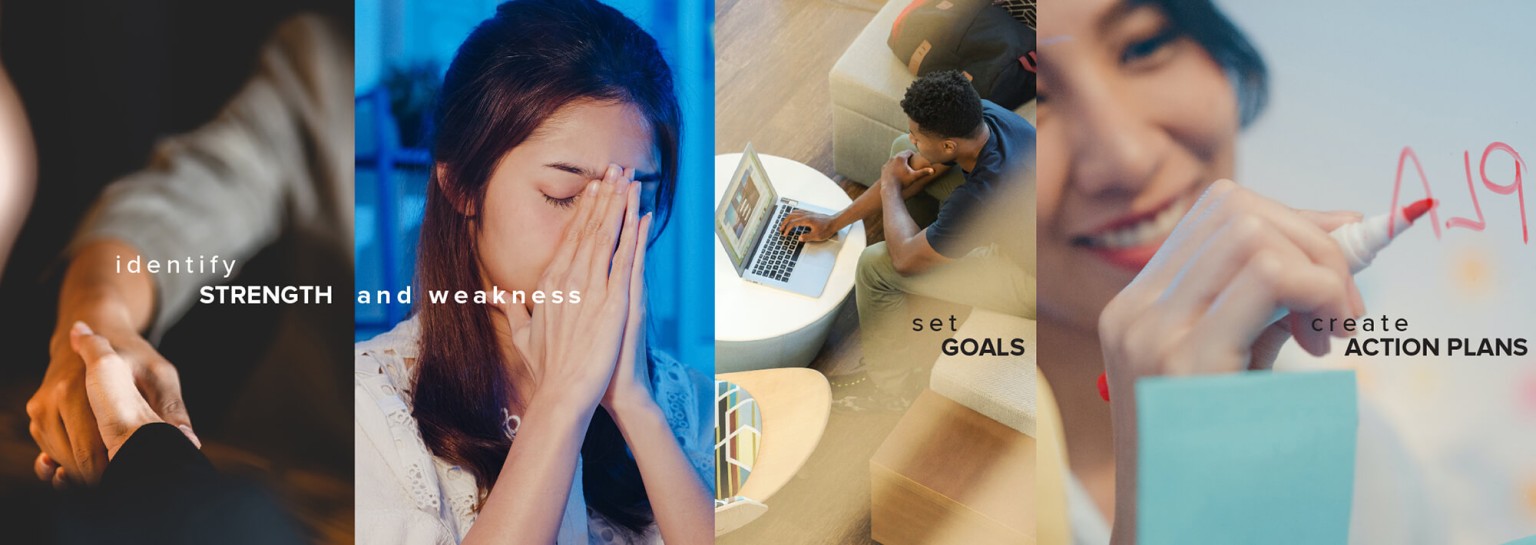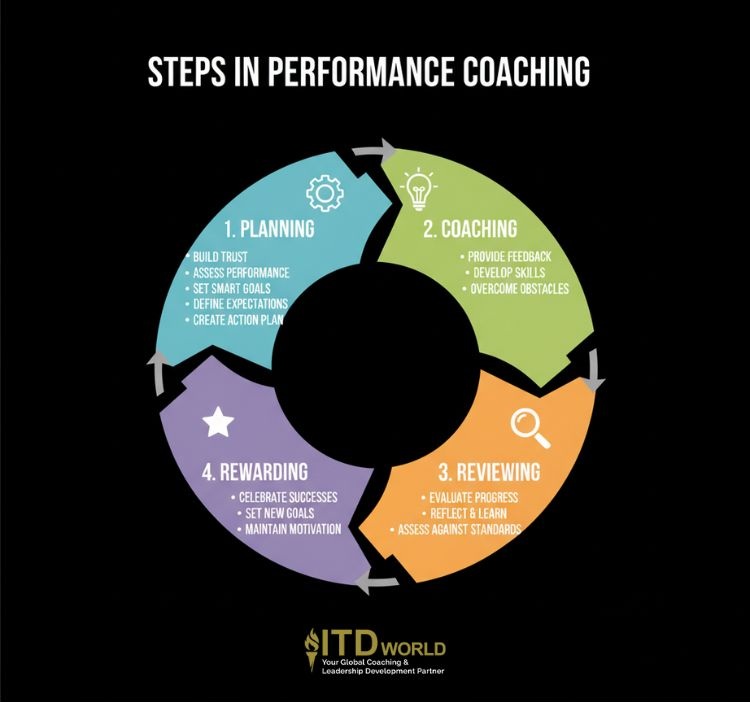Exceptional leaders have one thing in common: the ability to unlock people’s potential. They see what others do not and help others achieve things they never thought possible – through the use of performance coaching.
|
Author: Jonathan M. Pham |
Highlights
- Definition and Process: Performance Coaching is a type of coaching that helps individuals and organizations realize their potential and achieve goals across various fields (sports, business, personal development). The process involves the coach identifying the client’s strengths/weaknesses, setting powerful goals, developing action plans, and serving as a supportive accountability partner.
- Key Workplace Benefits: In the workplace, performance coaching leads to significant advantages, including increased self-awareness and confidence, enhanced skills and competencies, improved communication and collaboration, higher employee engagement and job satisfaction, reduced turnover, and strengthened succession planning.
- Performance Coaching Models: The field uses various structured frameworks to guide coaching conversations. The most well-known is GROW (Goal – Reality – Options – Will), which provides a simple, effective structure for goal setting and barrier resolution. Other models include CLEAR, OSKAR, and CIGAR.
- Techniques and Phases: Effective coaching relies on techniques like asking open-ended questions, active listening, using metaphors, role-playing, and providing feedforward (future-focused input). The coaching process typically follows four phases: Planning (setting SMART goals), Coaching (providing feedback and skill development), Reviewing (evaluating progress), and Rewarding (celebrating success and setting new goals).
- Measuring Success and Required Skills: Success is measured by goal achievement, skill development, positive behavior change, and overall impact (e.g., ROI, reduced turnover). Essential skills for a performance coach include Empathy and Emotional Intelligence, effective Communication, a Growth Mindset, and the ability to Empower coachees to find their own solutions.
What is Performance Coaching?
Performance coaching is a type of coaching that enables individuals and organizations to realize their hidden potential and visualize goals. It can be applied to a variety of areas and a lot of purposes – examples include:
- Sports: A soccer team needs to develop better communication and coordination on the field.
- Business: A sales manager would like to enhance their ability to delegate tasks effectively to the team.
- Personal development: An executive is looking to come up with a realistic, inspiring plan to change his habit and abandon old destructive behavior – so as to improve his professional relationships and the organization’s overall health.
- etc.
Typically, the process involves a coach working with clients to identify their strengths and weaknesses, set powerful goals, build up action plans to achieve these targets, and later act as a supportive accountability partner – so that their clients may stay on track all the time. Actionable feedback and seamless collaboration serve as two crucial pillars that potentially decide the end results of the relationship.

How Does Performance Coaching Work?
Performance coaching typically begins with an initial consultation – during which a coach and their client will discuss the goals of coaching, the areas in which the latter would like to improve, as well as their current skills and knowledge. After the initial conversation, the two parties may schedule to meet regularly to work on goal setting, developing action plans, and providing 360-degree feedback.
Depending on the specific circumstance, the conversation may take a different flow. Below is a basic example:
Coach: I’ve noticed that you’ve been missing some deadlines lately. Can you talk to me about what’s going on?
Employee: I’m just feeling really overwhelmed. I have a lot on my plate right now, and I’m having trouble keeping up.
Coach: I understand. It’s important to prioritize your tasks so that you’re working on the most important things first. Can you tell me more about what you’re working on right now?
Employee: I’m working on a presentation for next week, and I’m also trying to finish up a report that’s due at the end of the month.
Coach: Okay, so those are two pretty big tasks. It’s no wonder you’re feeling overwhelmed. Let’s try to break them down into smaller steps. For the presentation, what do you need to do first?
Employee: I need to research the topic and come up with an outline.
Coach: Great. Let’s schedule some time next week to work on that together. We can also brainstorm some ideas for how to prioritize your other tasks.
That’s a quick demonstration of how the process works – including steps such as identifying the root cause of one’s problem (feeling overwhelmed) and developing a plan to produce better results (prioritizing tasks and breaking down large tasks into smaller activities).
Benefits of Performance Coaching in the Workplace
Coaching is unlocking people’s potential to maximize their own performance.
John Whitmore, author of Coaching for Performance
- Increased self-awareness & confidence
Performance coaching provides a safe space for employees and leaders to reflect on their abilities and behaviors. Through introspective conversations and assessments, individuals have the chance to gain insights into their strengths and weaknesses – which helps nurture a growth mindset and encourages them to view challenges as opportunities for learning and improvement.
Consequently, this newfound self-awareness also contributes to boosting confidence and self-efficacy, as team members become better equipped to overcome obstacles and celebrate their achievements with a sense of pride.
- Enhanced skills & competencies
A core aspect of performance coaching is skill development. Coaches work with employees and leaders to list down specific competencies necessary for their roles and responsibilities (e.g. empathy, conflict resolution, decision-making, team management). Constructive feedback, role-playing, and practical exercises during coaching sessions facilitate continual improvement for success.
- Improved communication & collaboration
Effective teamwork is vital in any workplace. Performance coaching helps team members learn to express their ideas clearly, listen actively and empathetically, ask thought-provoking questions, and provide and receive feedback gracefully. This not only enhances interpersonal relationships within the organization – but also contributes to smoother interactions with clients, stakeholders, and management.
- Higher engagement & job satisfaction
One of the most significant impacts of coaching is on employee motivation and engagement. Coaches assist individuals in aligning their personal aspirations with the organization’s vision and values. By addressing potential obstacles and providing guidance, coaching ensures that employees remain inspired and committed to their work.
- Reduced turnover
An indirect, yet crucial benefit of performance coaching is its role in reducing turnover rates. As employees feel more valued, engaged, and equipped to handle their responsibilities, they are less likely to seek opportunities elsewhere. The coaching process equips team members to build a stronger connection with their roles and the organization, increasing their loyalty and commitment over time.
- Strengthened organizational health
When employees and leaders are empowered to perform at their best, it results in a more vibrant and thriving workplace culture. Open communication, collaboration, and a focus on continuous improvement become ingrained in the company’s DNA, creating an environment that attracts and retains top talent.
- Improved succession planning
As individuals develop and refine their skills, they become better prepared for future leadership roles. Coaches can aid in identifying high-potential employees and provide targeted guidance to groom them for management positions. This proactive approach ensures a seamless transition within the organization, reducing the disruptions that can occur during workforce changes.
If you give a man a fish, you feed him for a day. But if you give him a fishing rod, you feed him for a lifetime.
Chinese proverb
When to Use Performance Coaching
I absolutely believe that people, unless coached, never reach their maximum potential.
Bob Nardelli, former CEO of Home Depot and Chrysler
Performance coaching is a versatile tool that may be applied in various scenarios to drive personal and professional growth – for example, when one needs to:
- Improve workplace performance: As employees and leaders become more proficient in their roles and address areas of improvement, their contributions to the organization become more impactful. This, in turn, leads to improved team and organizational performance, ultimately contributing to the achievement of business objectives and success in a competitive environment.
- Enhance competencies in a specific field or role: Whether it’s mastering communication, honing leadership abilities, becoming a more effective public speaker, or refining problem-solving skills, a coach can provide targeted guidance to accelerate the visualization of such goals.
- Resolve a daunting challenge: For example, preparing for a critical presentation, launching a new project, consistently missing deadlines, or receiving negative customer feedback are all situations where a coach may come in to aid in formulating strategies and building up the confidence to overcome these hurdles.
- Monitor development progress: Performance coaching is valuable for those who require ongoing feedback and support to keep track of their progress and adjust their actions. A continuous feedback loop from a coach ensures that one may stay on the right path toward their objectives, make necessary improvements, and sustain their growth over time.
- Navigate a difficult transition: Managing transitions, such as promotions or new assignments, often proves to be challenging. In such cases, one may appreciate a coach who can assist in setting clear expectations, adapting to new responsibilities, and developing the skills and mindset needed for success in the new position.
- Maintain motivation & engagement: Staying motivated and engaged in one’s work is essential for long-term success and job satisfaction. Performance coaching can be used to reignite motivation, enhance focus, and maintain a high level of commitment – even during challenging times.
Remember, performance coaching is not a one-time event; rather, it is an ongoing process. The effects are cumulative – the more frequently you receive coaching, the more significant the end results will be.

Performance Coaching Models
- GROW (Goal – Reality – Options – Will): Developed by Sir John Whitemore himself, the GROW model provides a straightforward and comprehensive structure for coaching conversations, making it highly effective in enabling people to set and achieve their goals while addressing any barriers they may encounter.
- CLEAR (Contract – Listen – Explore – Action – Review): With this approach, the emphasis is placed on establishing a solid foundation, active listening, thorough exploration, and ongoing evaluation to guide coachees toward improved performance.
- OSKAR (Outcome – Scale – Know – Actions – Review): This model is particularly well-suited for tasks and projects that require specific results, allowing individuals to focus on the necessary actions and resources.
- CIGAR (Challenge – Impact – Goal – Actions – Review): CIGAR is especially useful when one requires guidance in overcoming specific obstacles or when addressing difficult situations.
Read more: Executive Coaching for Sustainable Results
Performance Coaching Techniques
- Asking open-ended questions: Open-ended questions create space for coachees to explore their ideas, feelings, and perspectives more deeply; as a result, they stimulate critical thinking and self-reflection, so that coachees gain clarity into their challenges/ aspirations and are able to come up with more detailed, thoughtful responses. For instance, “What are some ways you think can help overcome these obstacles?” is much better than “Have you tried ABC to resolve your current issues?”.
- Active listening: Active listening goes beyond hearing words; it involves genuinely doing one’s best to understand others’ emotions, concerns, and intentions (also called empathetic engagement) – before validating/ reflecting on what has just been said. This technique is crucial for coaches to seek clarification, ask follow-up questions, and ensure that they grasp the coachee’s message accurately.
- Using metaphors & stories: Storytelling is a compelling tool to explain complex concepts or provide new perspectives – thereby making people more engaged in the coaching process and enhancing the retention of key insights.
- Role-playing: Role-playing is a hands-on technique that allows coachees to practice and refine new skills/ behaviors in a controlled and supportive environment. By stimulating real-life scenarios, one has the chance to refine their confidence and become better prepared to handle issues in the workplace.
- Visualizing success: Visualization is a powerful method for keeping coachees motivated and focused on their goals, strengthening their commitment, and providing a roadmap for them when they feel lost at any time during the process.
- Feedforward: Unlike traditional feedback, feedforward takes a more constructive approach – specifically, it emphasizes providing input in a positive manner, and proposing actionable steps instead of dwelling on past performance.
Coaching focuses on future possibilities, not past mistakes.
John Whitmore
Steps in Performance Coaching
Generally speaking, the process of performance coaching can be broken down into 4 phases – each of which involves a plethora of activities:
-
Planning
- Building trust and rapport: Establishing trust and rapport is the foundation of a successful coaching relationship. Both parties must feel comfortable with each other, so that open communication and collaboration may become possible.
- Assessment of current performance: To ensure a good starting point, the coach starts by gathering information about the coachee’s current status. This assessment may involve interviews, observations, and reviews of past performance data – so as to come up with a baseline for setting improvement objectives.
- Setting SMART Goals: The coach works with the coachee to define SMART goals (Specific, Measurable, Achievable, Relevant, and Time-bound) – which serve to provide a clear direction for the process and make sure that objectives are attainable.
- Defining expectations and standards: Next, both parties must settle on the expectations, standards, and criteria for success. This step clarifies what excellence looks like – based on which the coachee may understand what is expected of them.
- Creating a shared vision and action plan: Together, those involved develop a realistic performance coaching plan that outlines the steps, resources, and timelines needed to visualize the set goals. This plan serves as the main roadmap for the journey.
-
Coaching
- Providing ongoing feedback: The coach continuously provides specific and constructive input on the coachee’s progress and performance. Additionally, they assist in identifying obstacles, challenges, or difficulties that may arise and work collaboratively to find solutions.
- Skill development: Various techniques may be employed to aid the coachee in improving their existing skills and acquiring new ones. These may involve skill-building exercises, role-playing, and other hands-on approaches to development.
-
Reviewing
- Evaluating progress: In this phase, both parties assess the progress made toward the established goals. They measure performance against the criteria and standards set during the planning stage – so as to gauge how well the coachee is moving toward their objectives.
- Reflecting & Learning: Here, the coachee is encouraged to reflect on their experiences, strengths, weaknesses, and achievements – so as to enhance their own self-awareness and come up with insights for future growth.
-
Rewarding
- Celebrating successes: The coach plays a crucial role in acknowledging and celebrating the coachee’s achievements. Positive reinforcement, appreciation, and encouragement are essential for maintaining motivation and morale.
- Setting new goals: Last but not least, the coach assists the coachee in identifying new goals and areas for improvement based on the outcomes of the coaching process. This step ensures that the latter continues to strive for growth and excellence.

Performance coaching template
How to Measure the Success of Performance Coaching
- Goal achievement: Determine whether the coachee has achieved the specific goals set at the beginning of the coaching relationship. This can be assessed through quantitative measures such as target metrics or qualitative assessments based on the coachee’s self-evaluation and feedback from relevant stakeholders. Tools such as feedback forms, surveys, assessments, and reports may come in handy.
- Skill development: Assess if the coachee has improved their skills and competencies in the targeted area. Pre- and post-tests, 360-degree feedback, and observations can be employed for this purpose.
- Behavior change: Observe whether the coachee has made positive, sustainable changes in their behavior based on self-reports, ratings, testimonials, or observations.
- Impact: Evaluate the coachee’s impact on themselves, their team, organization, or community as a result of coaching. This can be measured through various means, such as return on investment (ROI), return on expectations (ROE), key performance indicators (KPIs), or reduced turnover rates.
Tips for Effective Performance Coaching
Effective performance coaching is a dynamic and collaborative process that requires thoughtful engagement and a commitment to growth. For those seeking to coach employees for peak performance, below are some principles to keep in mind:
- Ask for input: Solicit input from your coachee to gain a deep understanding of their perspective, challenges, and goals. Listen to their insights and concerns without judgment – so as to demonstrate empathy and commitment to addressing their unique needs.
- Offer regular feedback: Feedback is fundamental to effective coaching. Offer timely and constructive input to help coachees maintain awareness of their current performance and areas for improvement – as well as reinforce their positive behavior.
- Follow up: Recognize that your coachee may occasionally experience periods of stress or uncertainty. It’s your role as a coach to provide ongoing support and motivation during these times. Remind them that setbacks are part of the learning process and an opportunity for growth.
- Encourage learning & experimentation: Emphasize that mistakes are valuable learning opportunities. Encourage coachees to reflect on their experiences, extract lessons from their setbacks, and apply those lessons to future endeavors.
Read more: 10 Characteristics of a Good Coach

Skills Needed for Performance Coaching
If you plan to get a job in performance coaching, here are some core competencies that you should seek to develop:
- Teamwork: Coaches must excel in collaboration, working seamlessly with coachees, fellow coaches, and stakeholders to achieve shared objectives. Effective teamwork fosters a supportive environment conducive to growth and development.
- Empathy & Emotional Intelligence: Empathy is crucial to connect with the emotions, experiences, and perspectives of coachees – thereby forming the foundation of a trusting relationship. On the other hand, the ability to manage emotions enables one to maintain composure and adapt their approach to suit different needs and situations.
- Communication: Effective communication is pivotal for coachees to comprehend and act upon coaching insights. For long-term success, coaches should employ various communication modes, including verbal, written, visual, and digital, to accommodate diverse learning and communication styles among coachees.
- Empowerment: Coaches empower coachees by utilizing Socratic questioning techniques that stimulate critical thinking, creativity, and problem-solving. Rather than dictating solutions, one should aim to facilitate others’ self-discovery and ownership of their learning and development.
- Growth mindset: Coaches must firmly believe in their own and their coachees’ capacity to learn, grow, and improve. This mindset is essential to fostering resilience and a commitment to continuous development.
Read more: 8 Effective Coaching Skills for Leaders & Managers
Discover ITD World’s Performance Coaching Certification Course
At ITD World, we offer a transformative and comprehensive certification program known as the Certificate in Performance Coaching (CPC) – which stands as a testament to their commitment to developing world-class coaches who can unlock potential, drive performance, and catalyze growth in individuals and organizations.
With CPC, participants are able to learn from a faculty of highly experienced and certified experts who bring a wealth of real-world coaching knowledge to the program. The content is designed to be highly engaging and interactive, with a blend of theoretical knowledge and practical application – so that participants can gain hands-on experience through real-life coaching scenarios and exercises.
Contact ITD World today to learn more about our performance coaching programs – plus various other professional competency certification courses developed by our team of globally certified trainers!
Other resources you might be interested in:
- Agility Coaching: Navigating Change & Fueling Business Success
- Mentoring: Guide to Establishing a Win-Win Relationship
- One-on-one Coaching: The Art of the Breakthrough
- Team Coaching for High Performance
- Building High-performing Teams: Power Up Your People for Success



